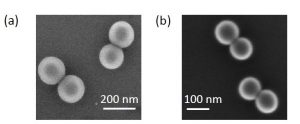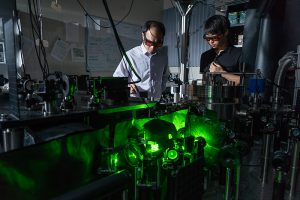Most people are aware of the fact that in order to learn more about the Universe scientists are constantly striving to develop more precise, more sensitive measuring instruments. Now scientists at Purdue University have succeeded in constructing the world’s fastest man-made vibrating and rotating objects. Devices that could be turned into scientific instruments of unparalleled sophistication.
What Professors Tongcang Li and Jonghoon Ahn of Purdue’s Department of Physics and Astronomy along with the Birck Nanotechnology Center have done is to fabricate silica particles in a dumbbell shape as small as 170 nm in length (that’s less than one fifth of a millionth of a meter). These particles are then levitated in a vacuum chamber by means of a 500 mW laser. Think of how light these particles must be if they can be held up by half a watt of light! The images below, taken with an Scanning Electron Microscope or SEM, show several of the silica particles.

Now, laser light is a part of the electromagnetic spectrum and therefore contains electric and magnetic field components which oscillate at the frequency of the light. These oscillations can take two forms known as polarizations, the first is called linear polarization, see animation below, because the electric and magnetic field components go up and down, or back and forth on a line.

The second form of polarization is called circular polarization because the field components rotate around in a circular motion. See figure below. The circular motion can be either clockwise (Also called left handed) or counter-clockwise (right handed).

The effect of these two kinds of polarization on the silica dumbbells is quite different. Linear polarization causes the dumbbells to begin to vibrate along the line of polarization while circular polarization causes the dumbbells to rotate. With the technology that they have developed the researchers at Purdue have surpassed one billion vibration or rotations every second. The image below shows Professors Li and Ahn at work in their Lab.

Impressive as those results are, how does that make these silica nano-dumbbells more sensitive, more precise scientific instruments? Well the dumbbells themselves held up by the laser are functionally identical to an instrument know as a torsion balance that was invented by Henry Cavendish to measure the value of Newton’s gravitational constant. The scientists at Purdue hope that their version of Cavendish’s instrument will be capable of measuring gravity at the atomic level giving physicists clues into the nature of quantum gravity!
Also, the rotating particles could be used to study the nature of the quantum vacuum through an effect known as vacuum friction. If you’re thinking that there’s nothing in a vacuum to generate friction you have to remember that we’re talking about the quantum world here. According to Quantum Field Theory virtual particles pop into and out of existence continually and these can interact with the rotating dumbbell causing friction. Vacuum fiction was predicted decades ago but has still never been directly observed, hopefully Purdue’s rotating particles will soon give us a better window into the reality of the quantum field.
Experimental measurements are the way we actually know things, theories on the other hand are the connections between our measurements. The more precisely we can measure things, the more different ways we have to measure things the more we know. It’s as simple as that.
